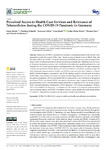Perceived Access to Health Care Services and Relevance of Telemedicine during the COVID-19 Pandemic in Germany
Reitzle, Lukas
Schmidt, Christian
Färber, Francesca
Huebl, Lena
Wieler, Lothar Heinz
Ziese, Thomas
Heidemann, Christin
During the COVID-19 pandemic in Germany, non-pharmaceutical interventions were imposed to contain the spread of the virus. Based on cross-sectional waves in March, July and December 2020 of the COVID-19 Snapshot Monitoring (COSMO), the present study investigated the impact of the introduced measures on the perceived access to health care. Additionally, for the wave in December, treatment occasion as well as utilization and satisfaction regarding telemedicine were analysed. For 18–74-year-old participants requiring medical care, descriptive and logistic regression analyses were performed. During the less strict second lockdown in December, participants reported more frequently ensured access to health care (91.2%) compared to the first lockdown in March (86.8%), but less frequently compared to July (94.2%) during a period with only mild restrictions. In December, main treatment occasions of required medical appointments were check-up visits at the general practitioner (55.2%) and dentist (36.2%), followed by acute treatments at the general practitioner (25.6%) and dentist (19.0%), treatments at the physio-, ergo- or speech therapist (13.1%), psychotherapist (11.9%), and scheduled hospital admissions or surgeries (10.0%). Of the participants, 20.0% indicated utilization of telemedical (15.4% telephone, 7.6% video) consultations. Of them, 43.7% were satisfied with the service. In conclusion, for the majority of participants, access to medical care was ensured during the COVID-19 pandemic; however, access slightly decreased during phases of lockdown. Telemedicine complemented the access to medical appointments.
Dateien zu dieser Publikation

